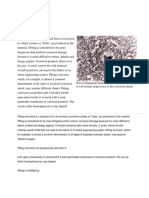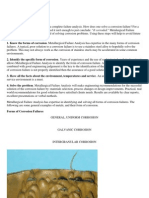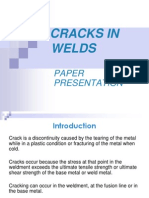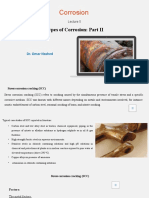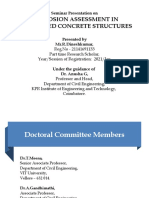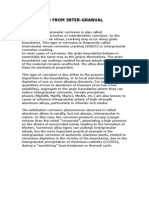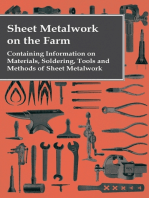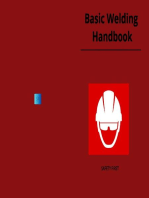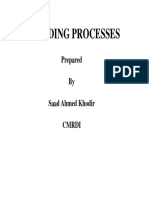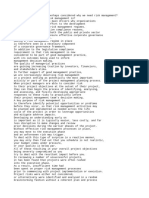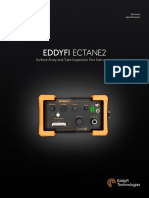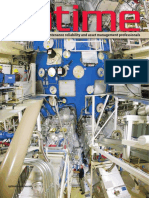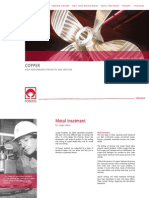Corrosion: Processes Leading To Defects in Carbon Steel
Corrosion: Processes Leading To Defects in Carbon Steel
Uploaded by
mohamed al-amirCopyright:
Available Formats
Corrosion: Processes Leading To Defects in Carbon Steel
Corrosion: Processes Leading To Defects in Carbon Steel
Uploaded by
mohamed al-amirOriginal Description:
Original Title
Copyright
Available Formats
Share this document
Did you find this document useful?
Is this content inappropriate?
Copyright:
Available Formats
Corrosion: Processes Leading To Defects in Carbon Steel
Corrosion: Processes Leading To Defects in Carbon Steel
Uploaded by
mohamed al-amirCopyright:
Available Formats
Processes Leading to Defects in Carbon Steel
Of course, carbon steel is not impervious to defects. They are usually the result of one or several of the following processes:
Segregation
In metallurgy, this is a process where one component of an alloy or solid solution separates in small regions within the solid or on the solid’s
surface. Segregation causes irregularities in the properties of the carbon steel, usually adverse to the
quality of the metal, and zones of reduced corrosion resistance in the immediate vicinity of segregation.
Porosity
This is defined as void spaces on or in the material. It appears often in castings. In weld metal, it’s usually the result of gas being trapped inside. In
castings, Often, porosity is the root cause of coating failures, which manifest themselves as surface
pitting, spotting, and corrosion.
Shrinkage (or Hot Cracking)
This is the formation ofcracks during the solidification of metal . The process is also known as hot shortness, hot
fissuring, solidification cracking, and liquation cracking. Hot cracking usually occurs when the available supply of liquid weld metal is insufficient to
fill the space available to solidifying metal.
Inclusions
oxides
These are particles, larger than ~0.5 µm, generally found in all steels, even the very purest. The most common inclusions in steel are
and sulphides, but also include nitrides and silicates, which are all non-metallic. Such inclusions can lead
to cause cracks such as sulphide-stress cracking (SSC) and fatigue failures.
Residual Stresses
Residual stresses are the stresses remaining in a solid material after their original cause is removed. These stresses, if uncontrolled, can lead to
the premature failure of critical components.
Embrittlement
loss of material ductility, making it brittle and prone to cracking. The absorption of hydrogen
This process is a
sulfide, leading to SSC, embrittles carbon steel. Similarly, CS absorbing hydrogen leads to hydrogen embrittlement,
which can cause the metal to fracture.
Fatigue
cyclic loading. If the loads are above a certain
Progressive and localized structural damage occurring when a material is subjected to
threshold, microscopic cracks begin to appear at stress concentrators such as the surface,
persistent slip bands, and grain interfaces. Eventually, cracks reach a critical size, propagating suddenly, resulting in failure.
Carbon steel weld covered in paint
Defects Found in Carbon Steel
Cracking
Cracking is the most prevalent type of defects in in-service carbon steel welds. Cracks come in various shapes and
sizes, from surface-breaking cracks to stress-corrosion cracking (SCC). Some of the
challenges of inspecting CS surfaces for defects are that they are often rough (hard on surface probes) and very often coated
with paint or other types of protective coatings. These often need to be removed to perform surface
inspections and then reapplied, which is both costly and time consuming, not to mention harmful to the environment.
Cracking includes:
Longitudinal cracks parallel to the weld axis that may be along the
: Breaks in the surface
centerline of the weld, close to the weld toes, or in the heat-affected zone (HAZ), for example.
Transverse cracks : Breaks in the surface perpendicular to the weld axis that may be
completely within the weld metal or may extend from the weld metal into the base metal.
Crater cracks: Breaks in the surface that occur at the crater of a weld because welding was improperly
star cracks.
terminated. Crater cracks are also referred to as
Branching cracks: Clusters of connected cracks originating from a common
crack.
Stress-corrosion cracking: Crack growth leading to the failure of metals under the combined
action of corrosion and stress.
Liquid penetrant testing on carbon steel weld
Other Types of Surface Defects
As mentioned above, a number of other types of defects can develop in base metal carbon steel and CS welds:
Corrosion: Gradual material destruction by chemical reactions with the surrounding environment
Surface porosity: Gas pores that break the carbon steel surface
Lack of fusion: Poor adhesion of the weld bead to the base metal
Pitting: Form of extremely localized corrosion leading to the creation of small “pits” in the metal
Dents: Depressions in surfaces from pressure or blows
Detecting Defects in Carbon Steel
regularly inspected for
To prevent failures and prolong the life of assets, structures, and equipment, carbon steel must be
defects. There are several standards governing this activity, published by ASTM International, the American Society of Mechanical Engineers (ASME)
and the International Standards Organization (ISO). These standards state that ultrasonic testing (UT), eddy current testing (ECT, including eddy current
array), magnetic particle testing (MT), and liquid penetrant testing (PT) may be used to inspect for surface-breaking defects, according to specific guidelines.
ASTM E3052-16
ASTM E3052-16 covers the use of ECA sensors for the non-destructive te
You might also like
- Casting Defects & RemediesDocument40 pagesCasting Defects & RemediesMurali80% (5)
- Dacon Pulsed Eddy Current Presentation 2016Document16 pagesDacon Pulsed Eddy Current Presentation 2016mohamed al-amirNo ratings yet
- Welding Defect: Hydrogen EmbrittlementDocument8 pagesWelding Defect: Hydrogen EmbrittlementShajin Mohammed ShamsudhinNo ratings yet
- Corrosion On Stainless SteelDocument3 pagesCorrosion On Stainless SteelMondayNo ratings yet
- Materials Corrosion - Basic Types of Corrosion That Designers and Engineers Must BeDocument4 pagesMaterials Corrosion - Basic Types of Corrosion That Designers and Engineers Must BeSandeep PrajapatiNo ratings yet
- basicofcorrosionDocument59 pagesbasicofcorrosionsupriya purohitNo ratings yet
- Types of Corrosion 1Document30 pagesTypes of Corrosion 1Lion ManabatNo ratings yet
- 10 Common Types of Corrosion in Metals (With Examples)Document22 pages10 Common Types of Corrosion in Metals (With Examples)SYED RAZI HASSANNo ratings yet
- Assignment 1Document9 pagesAssignment 1Muhammad AliNo ratings yet
- Metal Casting Is A Complex Process That Involves The Application of High Pressure To Molten MetalDocument7 pagesMetal Casting Is A Complex Process That Involves The Application of High Pressure To Molten MetalMaria SarwatNo ratings yet
- Stress Corrosion CrackingDocument16 pagesStress Corrosion Crackingzaxader0% (1)
- Stress Corrosion: CrackingDocument16 pagesStress Corrosion: CrackingvincrediableNo ratings yet
- Pitting CreviceDocument23 pagesPitting CreviceyayangNo ratings yet
- Pitting Action of MetalsDocument4 pagesPitting Action of MetalsRahamat ShaikNo ratings yet
- CorrosionDocument59 pagesCorrosionsparkshock100% (1)
- 3 Welding Imperfections and Materials InspectionDocument31 pages3 Welding Imperfections and Materials InspectionSampath KumarNo ratings yet
- Unit 3 Notes1Document25 pagesUnit 3 Notes1Kishore ImmanvelNo ratings yet
- Unit-2Document19 pagesUnit-2aswin367mayannurNo ratings yet
- Pitting CorrosionDocument6 pagesPitting CorrosionQcsss SHPLNo ratings yet
- Jenis Korosi Berdasarkan BentuknyaDocument52 pagesJenis Korosi Berdasarkan Bentuknyaari195No ratings yet
- Design For Corrosion Resistance: Uniform AttackDocument11 pagesDesign For Corrosion Resistance: Uniform AttackIndra PradanaNo ratings yet
- NDT Discontinuities - World of NDTDocument51 pagesNDT Discontinuities - World of NDTHòa NguyễnNo ratings yet
- Defect Related FailuresDocument24 pagesDefect Related FailuresAhmad AloudahNo ratings yet
- EN380 Naval Materials Science and Engineering Course Notes, U.S. Naval AcademyDocument13 pagesEN380 Naval Materials Science and Engineering Course Notes, U.S. Naval AcademyMad Max100% (1)
- Corrosion Types and Rust-Preventive CoatingsDocument20 pagesCorrosion Types and Rust-Preventive Coatingsefekan35100% (2)
- Metallurgical Failure AnalysisDocument4 pagesMetallurgical Failure AnalysisgirishnitwNo ratings yet
- Causes of CorrosionDocument3 pagesCauses of Corrosionamit100% (1)
- Cracks in WeldsDocument19 pagesCracks in Weldsjesycuban100% (1)
- Corrosion Prevention and ControlDocument54 pagesCorrosion Prevention and Controltrinojp181No ratings yet
- Industrial Chemistry B - Lecture 6Document64 pagesIndustrial Chemistry B - Lecture 6Daniel Rsix CornwallNo ratings yet
- CorrosionDocument8 pagesCorrosionGM VillaneaNo ratings yet
- Corrosion - Its Type and PreventionDocument3 pagesCorrosion - Its Type and Preventionpallab nathNo ratings yet
- CorrosionDocument31 pagesCorrosionLyle Joseph Legaspi100% (1)
- Corrosion and TypesDocument34 pagesCorrosion and Typesparamaguru vNo ratings yet
- Corrosion and ErosionDocument35 pagesCorrosion and ErosionCharles OnuhNo ratings yet
- 21 Types Casting DefectsDocument94 pages21 Types Casting DefectsNarayanakumar A.PNo ratings yet
- 5. Effect of Stress and SCCDocument38 pages5. Effect of Stress and SCCazhanfayazalveeNo ratings yet
- INTRODUCTION TO CORROSIONDocument8 pagesINTRODUCTION TO CORROSIONadewumidamilolasamuelNo ratings yet
- Corrosion, Prevention and ControlDocument60 pagesCorrosion, Prevention and ControlCherry Obias100% (1)
- 02 Forms of CorrosionDocument41 pages02 Forms of CorrosionNino AngobNo ratings yet
- Corrosion and Its Types: Engineering Material AssignmentDocument6 pagesCorrosion and Its Types: Engineering Material AssignmentHasieb Alam KhanNo ratings yet
- Types of CorrosionDocument2 pagesTypes of CorrosionMehulkumar PatelNo ratings yet
- Mini ProjectDocument14 pagesMini ProjectfaranimohamedNo ratings yet
- Corrosion Failures: Thirunavukarasu.H 13MY12Document47 pagesCorrosion Failures: Thirunavukarasu.H 13MY12soundrapandianNo ratings yet
- Corrosion 5Document16 pagesCorrosion 5كامل الفاخريNo ratings yet
- Etc.) - The Number of Grades Is Therefore Seemingly Infinite, With A Large NumberDocument16 pagesEtc.) - The Number of Grades Is Therefore Seemingly Infinite, With A Large Numberandres16012008No ratings yet
- PART 142 What Is Corrosion - Definition and PreventionDocument3 pagesPART 142 What Is Corrosion - Definition and Preventionravindra_jivaniNo ratings yet
- Casting DefectsDocument7 pagesCasting DefectsJackie KendiNo ratings yet
- Corrosion FormsDocument2 pagesCorrosion FormsKamal Hameed Al-taiyNo ratings yet
- CorrosionDocument20 pagesCorrosionDhruv SharmaNo ratings yet
- Corrosion Assessment in Reinforced Concrete StructuresDocument32 pagesCorrosion Assessment in Reinforced Concrete Structuresdineshkumar rNo ratings yet
- Chemistry Unit - 2 NotesDocument13 pagesChemistry Unit - 2 Notesjoshinihar19No ratings yet
- Prevention From Inter-Granual CorrosionDocument7 pagesPrevention From Inter-Granual CorrosionDevashish JoshiNo ratings yet
- Sheet Metalwork on the Farm - Containing Information on Materials, Soldering, Tools and Methods of Sheet MetalworkFrom EverandSheet Metalwork on the Farm - Containing Information on Materials, Soldering, Tools and Methods of Sheet MetalworkNo ratings yet
- Color Atlas Basic Technique for Metal Ceramics: An Introduction to Ceramic TechniqueFrom EverandColor Atlas Basic Technique for Metal Ceramics: An Introduction to Ceramic TechniqueNo ratings yet
- Tool-Steel - A Concise Handbook on Tool-Steel in General - Its Treatment in the Operations of Forging, Annealing, Hardening, Tempering and the Appliances ThereforFrom EverandTool-Steel - A Concise Handbook on Tool-Steel in General - Its Treatment in the Operations of Forging, Annealing, Hardening, Tempering and the Appliances ThereforNo ratings yet
- Why Do Metals Rust? An Easy Read Chemistry Book for Kids | Children's Chemistry BooksFrom EverandWhy Do Metals Rust? An Easy Read Chemistry Book for Kids | Children's Chemistry BooksNo ratings yet
- Weldingprocesses - (2-1) (Compatibility Mode)Document51 pagesWeldingprocesses - (2-1) (Compatibility Mode)mohamed al-amirNo ratings yet
- Steel AlloysDocument21 pagesSteel Alloysmohamed al-amirNo ratings yet
- 1 2 1-EnDocument2 pages1 2 1-Enmohamed al-amirNo ratings yet
- WP 2Document27 pagesWP 2mohamed al-amirNo ratings yet
- 1 9-EnDocument3 pages1 9-Enmohamed al-amirNo ratings yet
- Cases Study For Corrosion in Heat Affected Zone of Carbon SteelDocument15 pagesCases Study For Corrosion in Heat Affected Zone of Carbon Steelmohamed al-amirNo ratings yet
- Pinnacle - Quantitative Reliability Optimization (QRO) Executive BriefDocument9 pagesPinnacle - Quantitative Reliability Optimization (QRO) Executive Briefmohamed al-amir100% (1)
- Surface Array and Tube Inspection Test Instrument: Technical SpecificationsDocument4 pagesSurface Array and Tube Inspection Test Instrument: Technical Specificationsmohamed al-amirNo ratings yet
- Piping Anomaly Report: PAR No. NGCP/P/19/001Document3 pagesPiping Anomaly Report: PAR No. NGCP/P/19/001mohamed al-amirNo ratings yet
- مذكرة لغة انجليزية للصف الرابع الابتدائي ترم اول - ملزمتيDocument51 pagesمذكرة لغة انجليزية للصف الرابع الابتدائي ترم اول - ملزمتيmohamed al-amirNo ratings yet
- Maintenance Reliability and Asset ManagementDocument5 pagesMaintenance Reliability and Asset Managementmohamed al-amir100% (1)
- CDF - EnergyDocument2 pagesCDF - Energymohamed al-amirNo ratings yet
- Small Bore Piping Failures PDFDocument3 pagesSmall Bore Piping Failures PDFmohamed al-amirNo ratings yet
- Oceaneering Plant Inspector Description of Job Role - A Typical Day in The Life E.GDocument2 pagesOceaneering Plant Inspector Description of Job Role - A Typical Day in The Life E.Gmohamed al-amirNo ratings yet
- Audit Criteria: AC7114/1S REV. MDocument47 pagesAudit Criteria: AC7114/1S REV. MCaio Fazzioli TavaresNo ratings yet
- Navy NDT - Magnetic ParticleDocument5 pagesNavy NDT - Magnetic Particlebesmindo012345No ratings yet
- Copper 02Document12 pagesCopper 02hijzainNo ratings yet
- GM Visual Acceptance Crtieria For WheelsDocument25 pagesGM Visual Acceptance Crtieria For WheelsVinod Vindy KrishnaNo ratings yet
- ASTM A802!A802M - 95 (Reapproved 2010) - STD Practice For Steel Castings Surface Acceptance STD & Visual ExaminationDocument3 pagesASTM A802!A802M - 95 (Reapproved 2010) - STD Practice For Steel Castings Surface Acceptance STD & Visual ExaminationJoe Scopelite100% (1)
- Causes of Casting Defects With RemediesDocument6 pagesCauses of Casting Defects With RemediesKavita KaleNo ratings yet
- Niyama Criteria Niyama Criteria Niyama CriteriaDocument18 pagesNiyama Criteria Niyama Criteria Niyama CriteriaVarthini RajaNo ratings yet
- High Integrity Die Casting - Imdc Dec 2013 Silafont®, Magsimal® Und Castasil®Document62 pagesHigh Integrity Die Casting - Imdc Dec 2013 Silafont®, Magsimal® Und Castasil®Giacomo Zammattio100% (1)
- Engineering Materials and Metallurgy Notes PDFDocument0 pagesEngineering Materials and Metallurgy Notes PDFSenthilkumar Subbiah50% (2)
- Casting Defects, Causes, and RemediesDocument33 pagesCasting Defects, Causes, and Remediesahmedenghesham100% (3)
- Metal Casting: Design, Materials, and Economics: Qualitative ProblemsDocument11 pagesMetal Casting: Design, Materials, and Economics: Qualitative ProblemsJairo RamosNo ratings yet
- Visual ExaminationDocument20 pagesVisual ExaminationVenkateshNo ratings yet
- EC1 - Manufacturing Processes-Quiz 1Document7 pagesEC1 - Manufacturing Processes-Quiz 1AnandababuNo ratings yet
- Gravity Die CastingDocument59 pagesGravity Die CastingPra Vee80% (5)
- Production Engineering: Sample QuestionsDocument3 pagesProduction Engineering: Sample Questionserica_burton8232No ratings yet
- Level 2 MOCK TEST QuestionsDocument6 pagesLevel 2 MOCK TEST QuestionsamitNo ratings yet
- Ultrasonic Testing HandbookDocument29 pagesUltrasonic Testing HandbookP A Kumar100% (1)
- Manufacturing Technology AnswersDocument32 pagesManufacturing Technology AnswersDaRkSouLNo ratings yet
- Part A (Answer All Questions) Question 1 (20 Marks) : Material To Remove 30.0 70.0 40.0Document19 pagesPart A (Answer All Questions) Question 1 (20 Marks) : Material To Remove 30.0 70.0 40.0Shah MalikNo ratings yet
- MSS SP-54-2013Document7 pagesMSS SP-54-2013Boonhlua KhwansriNo ratings yet
- Corrosion: Processes Leading To Defects in Carbon SteelDocument4 pagesCorrosion: Processes Leading To Defects in Carbon Steelmohamed al-amirNo ratings yet
- High Pressure Die Casting Defects and Simulation Process by Computer Added Engineering-IrshadAliDocument19 pagesHigh Pressure Die Casting Defects and Simulation Process by Computer Added Engineering-IrshadAliKushagra Trivedi100% (1)
- ASTM E192 - 20Document4 pagesASTM E192 - 20aqaplastlabNo ratings yet
- Macro Porosity Formation A Study in High Pressure Die Casting D BlondheimDocument12 pagesMacro Porosity Formation A Study in High Pressure Die Casting D BlondheimJuan RuizNo ratings yet
- 5 2020 03 03!12 06 10 PM PDFDocument3 pages5 2020 03 03!12 06 10 PM PDFنيزو اسوNo ratings yet
- Production Technology Lecture Notes 2022-23 - NewDocument148 pagesProduction Technology Lecture Notes 2022-23 - Newスラヴァニ サイNo ratings yet
- 512 Gating ManualDocument232 pages512 Gating ManualLuis Angel Alvarado HernandezNo ratings yet
- Casting DefectsDocument109 pagesCasting DefectsUmesh Vasava0% (1)
- Surface Comparators For Steel Castings: Scrata"Document2 pagesSurface Comparators For Steel Castings: Scrata"bvphimanshu100% (2)


















